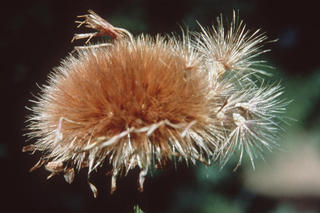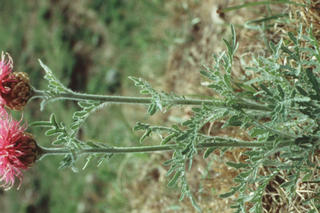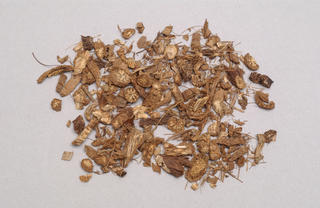Echinops latifolius
Contents
Nomenclature
Other Names:
Historical Use of Echinops latifolius
Echinops latifolius in Traditional Chinese Medicine
Background
Chinese Name (pinyin): Yuzhou Loulu
Chinese Name :
Common Name :Broadleaf Globethistle Root
Specific Name : Radix echinopsis
Scientific Name:
Collection : The drug is collected in spring or autumn, removed from rootlets and dried.
Description : Subcylindrical, slightly tortous, 10 - 25 cm long. 0.5 - 1.5cm in diameter. Externally greyish yellow or greyish-brown, wrinkled longitudinally, top brown fibrous rigid hairy. Texture hard, uneasily broken, fracture bark brown, wood showing radial striations, coloured in yellow alternating with black. Odour slight, taste slightly astringent.
Identification : Powder: Brownish yellow, phloem fibres in bundles, 20 - 42 µm in diameter with thickened walls, the interspaces of cells containing brown resinous substance. Xylem fibres slender, acuminate at two ends, 12 - 30 µm in diameter, walls relatively thick. Bordered pitted vessels and reticulated vessels more frequent, 20 - 120µm in diameter. Stone cells less frequent, subrounded, rectangular or square. 35 - 150 µm in diameter, markedly striated and pitted canalled. The interspaces of stone cells containing brown resinous substance. Inulin visible.
Processing : Eliminate foreign matter, wash clean, soften thoroughly, cut into thick slices and dry.
Action : To remove heat and counteract toxicity, drainage of pus, stanch bleeding, to cure sores and carbuncles, increase the secretion of milk.
Indication : carbuncle; mastitis with swelling and pain; galactostasis; scrofula and ulcers; ascariasis
Precautions : Contraindicated in pregnancy.
Dosage : 4.5 to 9 g.
Storage : Preserve in a ventilated dry place.
Nomenclature
Other Names:
Historical Use of Echinops latifolius
Echinops latifolius in Traditional Chinese Medicine
Background
Chinese Name (pinyin): Loulu
Chinese Name :
Common Name :Uniflower Swisscentaury
Specific Name : Radix rhapontici
Scientific Name:
Collection : The drug is collected in spring and autumn, removed from rootlet and soil and dried in the sun.
Description : Conical or flatted lumps, mostly twisted, varying in length, 1-2 cm in diameter. Externally greyish brown or dark brown, rough with longitudinal furrows and rhombic, netted clefts. Outer bark easily exfoliated. Root stock swollen with the remains of the stem and scaly leaf bases, top with greyish white pubescents. Texture light, fragile, easily broken, fracture irregular, greyish yellow, cleft, greyish black or brownish black in the center. Odour characteristic, taste slightly bitter.
Identification : To 1 g of the powder add 20 ml of methanol, ultra-sonicate for 20 minutes, filter, evaporate the filtrate on a water bath to dryness. Dissolve the residue in 1 ml of ethyl acetate and use it as the test solution. Prepare a solution of Radix Rhpontici reference drug in the same manner as the reference drug solution. Carry out the method for thin layer chromatography (Appendix Vl B) using silica gel G as the coating substance and cyclohexane butanone (4:1) as the mobile phase. Apply separately 5 µl of each of the two solutions to the plate. After developing and removal of the plate, dry it in the air. Examine under ultra violet light (365 nm). A spot in the chromatogram obtained from the test solution correspond in color to the spot in the chromatogram obtained from the reference drug solution.
Processing : Eliminate foreign matter, wash, clean soften thoroughly, cut into thick slices and dry in the sun.
Action : To remove toxic heat for treating subcutaneous infections, to promote lactation, and to relieve muscular contracture.
Indication : mastitis with swelling and pain, carbuncle, scrofula and ulcers; galactostasis; arthritis with ankylosis
Precautions : Used with caution in pregnancy.
Dosage : 5 to 9 g.
Storage : Preserve in a ventilated and dry place.
Synonymns for Echinops latifolius
Patent Medicines and Medicines with Multiple Ingredients that include Echinops latifolius
Pharmaceutical Information
Chemical Constituents
Evidence or the Use of Echinops latifolius in the Treatment of Epilepesy
Basic Science
Animal Studies
Cohort, Case-Control and Non-Randomized Trials
Randomized Controlled Trials
Meta-Analysis
1st Five Results: pubmed search
Ran Li, Yajuan Xia, Zhenzhen Gao, Yue Song, Zhiwei Guo, Ying Yang
Transcriptome analysis to reveal the mechanism of the effect of Echinops latifolius polysaccharide B on palmitate-induced insulin-resistant.
Biomed Pharmacother: 2021, 143;112203
[PubMed:34563954]
[WorldCat.org]
[DOI]
(I p)
Hai-Bo Wu, Hai-Bin Wu, Ming-Shan Kuang, Hui-Peng Lan, Yu-Xin Wen, Ting-Ting Liu
##Title##
J Agric Food Chem: 2020, 68(43);11939-11945
[PubMed:33059450]
[WorldCat.org]
[DOI]
(I p)
Jiaqi Wang, Xin Dong, Feixiang Ma, Chunyan Li, Ren Bu, Jingkun Lu, Jianping Gao, Peifeng Xue
Metabolomics profiling reveals Echinops latifolius Tausch improves the trabecular micro-architecture of ovariectomized rats mainly via intervening amino acids and glycerophospholipids metabolism.
J Ethnopharmacol: 2020, 260;113018
[PubMed:32502650]
[WorldCat.org]
[DOI]
(I p)
Qinghao Jin, Jin Woo Lee, Hari Jang, Ji Eun Choi, Hyung Sik Kim, Dongho Lee, Jin Tae Hong, Mi Kyeong Lee, Bang Yeon Hwang
Corrigendum to "Dimeric sesquiterpene and thiophenes from the roots of Echinops latifolius" [Bioorg. Med. Chem. Lett. 26 (2016) 5995-5998].
Bioorg Med Chem Lett: 2017, 27(6);1490
[PubMed:28202326]
[WorldCat.org]
[DOI]
(I p)
Qinghao Jin, Jin Woo Lee, Hari Jang, Ji Eun Choi, Hyung Sik Kim, Dongho Lee, Jin Tae Hong, Mi Kyeong Lee, Bang Yeon Hwang
Dimeric sesquiterpene and thiophenes from the roots of Echinops latifolius.
Bioorg Med Chem Lett: 2016, 26(24);5995-5998
[PubMed:27865705]
[WorldCat.org]
[DOI]
(I p)


